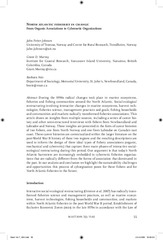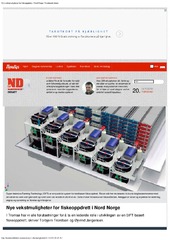Browsing Norges fiskerihøgskole by Title
Now showing items 1059-1078 of 1576
-
North Atlantic Fisheries in Change. From Organic Associations to Cybernetic Organizations
(Journal article; Tidsskriftartikkel; Peer reviewed, 2009) -
The Northern fisheries of the Russian Federation. Institutions in transition
(Master thesis; Mastergradsoppgave, 2005-05-23)The existing management system in the Russian fishing industry was created as a result of the political, economic and institutional transformations that took place in Russia after the dissolution of the Soviet Union in 1990. This thesis analyses the processes in the fisheries that led to the establishment of the existing institutional and management practice. The study seeks to find out how the ... -
The Norwegian coastal employment system: What It Was and What It Is
(Journal article; Tidsskriftartikkel; Peer reviewed, 2011)Norwegian fisheries have undergone tremendous changes, due to technological developments and the introduction of resource management. In addition, societal changes and in particular the introduction of formal requirements and the formalization of training and education, have also greatly affected the fishing fleet. Jentoft and Wadel (1984) described the Coastal Employment System. This system was ... -
Norwegian cod by-products in the Chinese market
(Master thesis; Mastergradsoppgave, 2019-05-14)This thesis is dedicated to studying the main factors which could affect Norwegian cod by-products in the Chinese market. Norway has been recognized as one of the biggest seafood countries in the world while China shows a preference towards Norwegian seafood. And due to the relationship has been better in the past few years between these two countries, it is worthy to discuss Norwegian seafood ... -
The Norwegian Snow Crab Industry. A case study of opportunities and threats in the Norwegian snow crab industry
(Master thesis; Mastergradsoppgave, 2019-05-15)The Norwegian seafood industry is constantly growing and expanding. The snow crab entering the Barents Sea was an opportunity to create a new, profitable industry with a product well established on the world market. Norwegian vessels entered the loophole and were joined by foreign vessels to catch snow crab. January 2017, Russia claimed sovereignty over the area and closed it for all foreign ... -
Novel antimicrobial peptides EeCentrocins 1, 2 and EeStrongylocin 2 from the Edible sea urchin Echinus esculentus have 6-br-trp post-translational modifications
(Journal article; Tidsskriftartikkel; Peer reviewed, 2016-03-23)The global problem of microbial resistance to antibiotics has resulted in an urgent need to develop new antimicrobial agents. Natural antimicrobial peptides are considered promising candidates for drug development. Echinoderms, which rely on innate immunity factors in the defence against harmful microorganisms, are sources of novel antimicrobial peptides. This study aimed to isolate and characterise ... -
A Novel Biosurfactant-Based Oil Spill Response Dispersant for Efficient Application under Temperate and Arctic Conditions
(Journal article; Tidsskriftartikkel; Peer reviewed, 2024-02-15)Synthetic oil spill dispersants have become essential in offshore oil spill response strategies. However, their use raises significant concerns regarding toxicity to phyto- and zooplankton and other marine organisms, especially in isolated and vulnerable areas such as the Arctic and shorelines. Sustainable alternatives may be developed by replacing the major active components of commercial dispersants ... -
A Novel Brominated Alkaloid Securidine A, Isolated from the Marine Bryozoan Securiflustra securifrons
(Journal article; Tidsskriftartikkel; Peer reviewed, 2017-07-23)A novel brominated alkaloid, Securidine A, was isolated from the cold water marine bryozoan Securiflustra securifrons. Securidine A was isolated using semi-preparative HPLC, and the structure was elucidated by spectroscopic methods. The isolated Securidine A was tested for cytotoxic, antibacterial, and anti-diabetic activities as well as for its potential for inhibition of biofilm formation. No ... -
A Novel brominated Alkaloid Securidine A, Isolated from the Marine Bryozoan Securiflustra securifrons
(Conference object; Konferansebidrag, 2017)A novel brominated alkaloid, Securidine A, was isolated from the cold water marine bryozoan Securiflustra securifrons. Securidine A was isolated using semi-preparative HPLC, and the structure was elucidated by spectroscopic methods. The isolated Securidine A was tested for cytotoxic, antibacterial, and anti-diabetic activities as well as for its potential for inhibition of biofilm formation. No ... -
Novel feeding interactions amplify the impact of species redistribution on an Arctic food web
(Journal article; Tidsskriftartikkel; Peer reviewed, 2020-06-01)Species are redistributing globally in response to climate warming, impacting ecosystem functions and services. In the Barents Sea, poleward expansion of boreal species and a decreased abundance of Arctic species are causing a rapid borealization of the Arctic communities. This borealization might have profound consequences on the Arctic food web by creating novel feeding interactions between ... -
Nuclease-Treated Stabilized Fermentation Product of Cetobacterium somerae Improves Growth, Non-specific Immunity, and Liver Health of Zebrafish (Danio rerio)
(Journal article; Tidsskriftartikkel; Peer reviewed, 2022-07-06)High-fat diets (HFD) are harmful to fish health. Probiotics are commonly utilized to improve fish nutrition metabolism, immune response, and health. Nucleic acids of the probiotic bacterium can be hydrolyzed by nuclease to generate nucleotides. The present study aimed to evaluate the effects of stabilized fermentation product of nucleasetreated Cetobacterium somerae XMX-1 [XMX-1 (N)] on growth, ... -
Nutrients as controlling factors of phytoplankton. Production in the Balsfjord - Northern Norway
(Master thesis; Mastergradsoppgave, 2009-05-15)Fisheries management research is mostly centered on providing the needed knowledge about the fish stock in order to influence fishermen’s behavior at sea for stock sustainability. Management should also integrate knowledge acquired from primary producers (particularly phytoplankton) which form the foundations for fish production in implementing fishing controlling measures. Phytoplankton production ... -
Nutritional composition of aquatic species in Laotian rice field ecosystems : possible impact of reduced biodiversity
(Master thesis; Mastergradsoppgave, 2008-05-22)The population density of Laos PDR has increased from 15 persons per square km in 1985 to 19 persons in 1995 and to 24 persons in 2005. This has threatened food security, which in Laos PDR is generally synonymous with rice availability. Rice production in Laos rose by 70 percent from 1990 to 2004. Evidence from Vietnam, Malaysia and Central Thailand has shown that the rise of rice production steadily ... -
Nutritional value and storage stability in commercially produced organically and conventionally farmed Atlantic salmon (Salmo salar L.) in Norway
(Journal article; Tidsskriftartikkel; Peer reviewed, 2022-12-16)Salmon feeds have changed over the years, leading to changed biochemical composition of the fish. The main aim of this study was to compare biochemical compositions and storage stability of commercially produced organic and conventional salmon. Organically (n = 40) and conventionally farmed salmon (n = 39) were sampled. The fish were anesthetized, killed by gill cutting and bled before filleting. ... -
Ny bransje i turbulente omgivelser – bedrifters strategiske tilpasninger og økonomiske konsekvenser
(Master thesis; Mastergradsoppgave, 2009-05-15)Torskeoppdrett er en ny bransje som de siste årene har vokst betraktelig. Med bakgrunn i bransjens mange problemer og utfordringer har lønnsomheten til nå vært svært dårlig. Den storstilte satsningen på torskeoppdrett har vært kapitalkrevende. Betydelig mengder kapital er spyttet inn av velvillige investorer. Med sine allerede eksisterende problemer og utfordringer er bedriftene i bransjen spesielt ... -
Ny teknologi gjør frossenfisken fersk
(Chronicle; Kronikk, 2016-01-14)En ny teknologi for opptining av fisk gjør det mulig å gjenvinne fersk kvalitet dersom fisken er frosset helt fersk. Det muliggjør overføring av oversjøisk transport av laks og ørret fra fly til skip, noe som kan redusere de norske klimagassutslippene med anslagsvis 800.000 tonn.<p> <p>Tineteknologien er EUpatentert av det norskeide tyske selskapet Coolnova UG. Blodferske fiskeprodukter kan ... -
Nye FoU-tilbud til sjømatindustri. Forslag til strategi for fiskeriforskningsmiljøet i Tromsø
(Research report; Forskningsrapport, 2000)Rapport fra en arbeidsgruppe nedsatt for å fremme forslag til ny strategi for fiskeriforskningsmiljøet i Tromsø for nye FoU-tilbud til sjømatindustrien. Gruppen fikk i oppgave å gi innspill til styrene i Norges Fiskerihøgskole og Fiskeri¬forsk¬ning om hvordan de to institusjonene i samarbeid kan styrke satsingen overfor norsk fiske- og sjømatindustri. Gruppens anbefalinger er at styrene i ... -
Nye vekstmuligheter for fiskeoppdrett i Nord Norge
(Chronicle; Kronikk, 2016-10-13) -
Næringsinnhold av mesopelagisk fisk. Nedbryting av laksesild (Maurolicus muelleri), med fokus på fett.
(Master thesis; Mastergradsoppgave, 2019-05-29)Det økende behovet for mat til en befolkning i vekst har ført til et utvidet søk etter nye ressurser og mer effektiv utnyttelse av eksisterende ressurser. For å øke det globale utbytte av den totale biomassen som produseres i havene, har det blitt foreslått å utnytte organismer lavere i næringskjeden, for å redusere tap av biomasse i energioverføringen blant organismene i næringskjeden. Mesopelagisk ... -
Næringsinnhold av økologisk og konvensjonell oppdrettslaks (Salmo salar L.)
(Master thesis; Mastergradsoppgave, 2022-05-11)Norges oppdrettsnæring har utviklet seg kraftig de siste tiårene, og har nå blitt verdens største produsent av atlantisk laks (Salmo salar L.). Den økte produksjonen har ført til økt etterspørsel etter råvarer til fôr. Samtidig har global oppdrett også vokst kraftig og etterspørselen etter fiskemel og fiskeoljer har økt. Dette, kombinert med begrenset tilgang, har gjort at prisene på fiskemel og ...


 English
English norsk
norsk


















